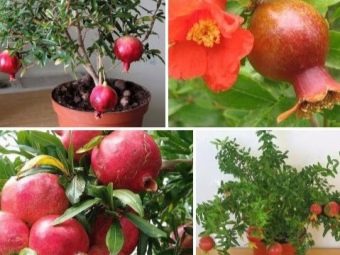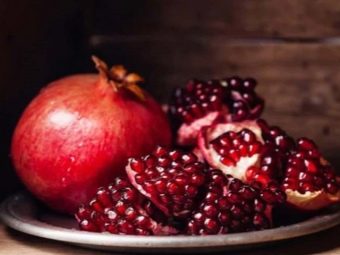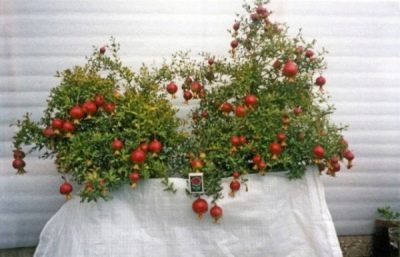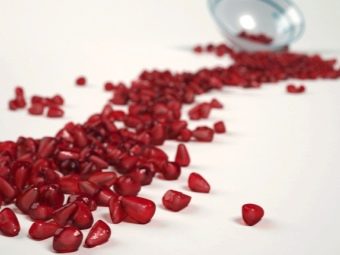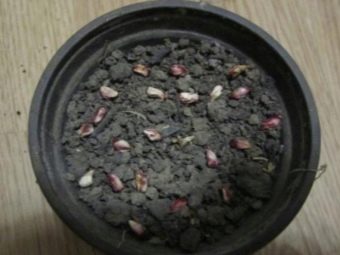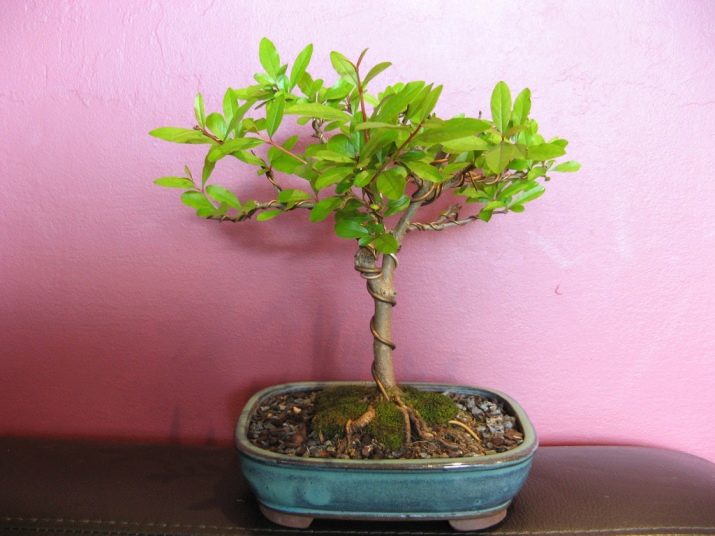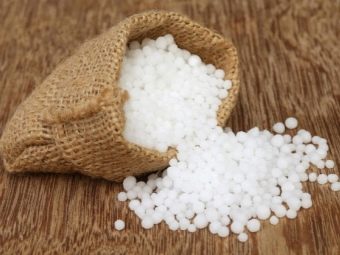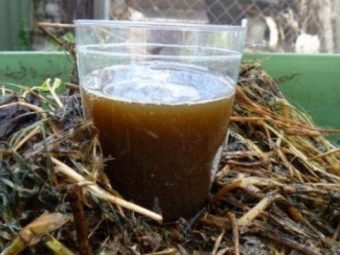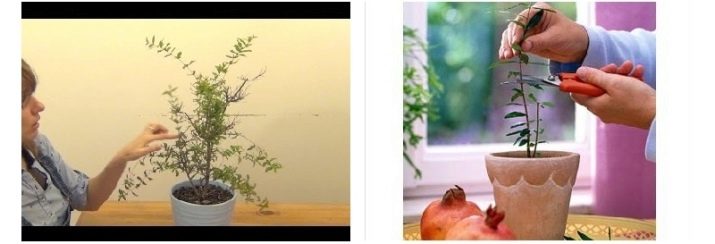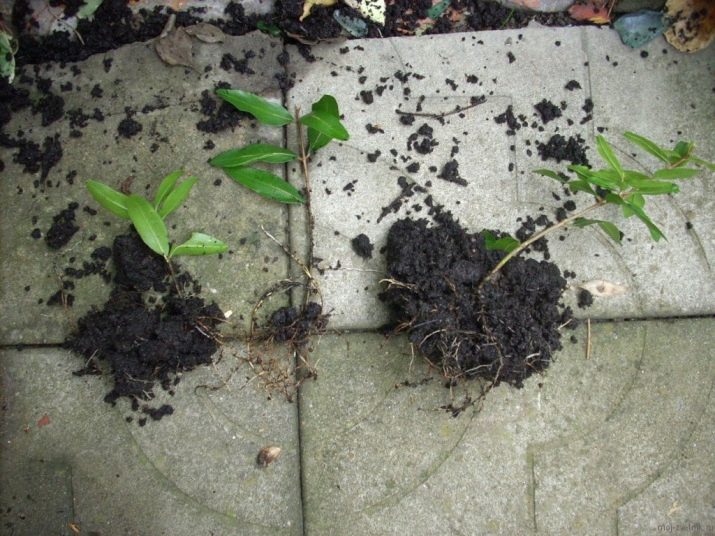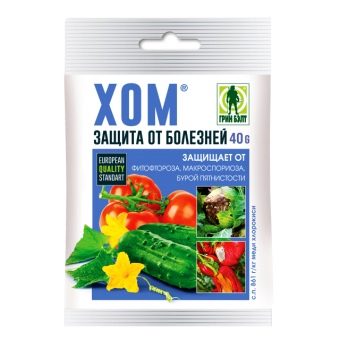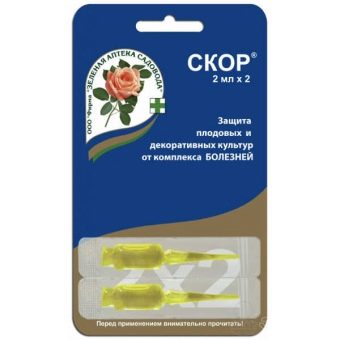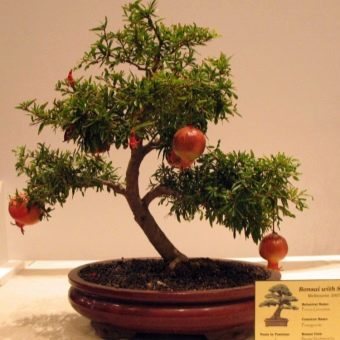Features of growing pomegranate from the bone at home
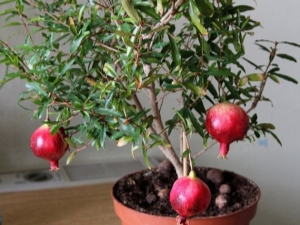
Among the exotic plants that flower growers choose for their home greenhouses, pomegranate is not very common. Most often it is grown from stone. Such miniature room grenades actively bloom and bear fruit with proper care. This plant has aromatic and unusual inflorescences, tasty and healthy fruits. When growing an abundant home crop should not be expected, but the decorative and beauty of such a small tree fully compensate for this drawback. Caring for pomegranate is simple and quite accessible to any lover of indoor plants.
Plant description
Pomegranate's native climate is subtropical Asia. It looks when growing in the open ground, like a stunted tree with a lush crown.
However, in the conditions of the house, a real pomegranate tree can be grown from a stone or cutting. In a pot, a pomegranate tree will grow no more than 1.5-2 meters, while in nature these plants can reach 5-6 meters in height. This is due to the fact that it is impossible to provide him with sun illumination in the room, comparable to the natural conditions, so it’s not necessary to be afraid to grow a giant in a pot. The light should be bright and diffused, so the window sill on the south side can be the best place for a pot of pomegranate, provided shading is created at noon, otherwise the leaves will get burned.
Home garnet blossoms very plentifully and year-round. This exotic tree is almost constantly decorated with inflorescences. The flower has the form of a gramophone, with a perianth bright red color of a rigid structure. The petals of the flower are of a delicate color, yellow, pink or white, depending on the variety. Pomegranate sprouted from the stone, will begin its flowering not earlier than the age of 3 years.
The trunk of the plant is thick, repeatedly forking. Branches are thin, have thorns. Leaves elongated, sharp to the ends.
Among all the advantages of this plant, the main thing is its fruits. They are usually round, with a hard skin, under which hides a lot of juicy grains with pits. The color of the fruit is brown, orange or red. Grains are separated by skin by sector. In one fruit, there may be about a thousand of such grains.
With a low calorie content, these fruits are a real treasure trove of microelements and vitamins. These are amino acids, vitamins A, B, vitamins C, E, PP, potassium, magnesium, phosphorus, calcium, iron, and fiber. All these substances are of great value for the human body, it was not for nothing that in Ancient Greece pomegranate was considered the food of gods.
Variety selection
For growing at home in the pot is better to choose dwarf varieties of this plant.
- Sort "Nana" has a height of up to 1 meter and looks like a real garden pomegranate, only on a smaller scale. Leaves, flowers, fruits, the shape of the trunk and crown - everything is exactly the same, only small.
- Variety "Baby" more miniature, its height reaches no more than 50 cm. The inflorescences are arranged in bunches of several pieces, the fruits of it are orange with a brown tint.
- Variety "Ruby" also a dwarf variety, the tree reaches a height of no more than 70 cm. As the name implies, fruits and flowers have a bright red color.
- Variety "Uzbekistan" - the smallest of the garden. It grows to a height of no more than 2 meters. Fruits are red, larger in comparison with dwarf varieties.
It is also possible to extract grain from a fruit and from a bone to cultivate a usual garden pomegranate in a pot. Its fruits will be few in number and lose to varietal taste, since usually you can find fruits of hybrid varieties that have already lost their parental signs. Such trees reach an adult height of no more than 1 meter.
Dwarf varieties for growing a house have an advantage in decorative qualities, they have foliage all year round, without dumping it for winter time.
Seed preparation
It is quite simple to germinate pomegranate from grains; the main thing is to choose the right seeds and maintain the soil in the right condition.
The seed for germination is selected fresh, not overdried, germination seeds lose very quickly. Before germination, they are soaked in water for a day, and it is important that some of them protrude from the water to allow air to enter. If the seed is taken from fresh fruit, then it must be thoroughly cleaned from the pulp and membranes, otherwise rotting after immersion in the ground is possible.
Sprouting a pomegranate from a purchased fruit will undoubtedly be very interesting, especially for beginner growers, for whom the growing process itself is important, rather than the result obtained.
It is important to choose a beautiful, healthy and large fruit for seed production. The skin should be clean from rot, mildew, traces of pests. It is quite difficult to find such a fruit in stores and on the market, so you should be careful when choosing.
At home, the fruit is peeled, and several grains are left to grow. Germination of pomegranate is very high, about 95%, so you can leave 5-6 grains. The seeds for sowing must be clean and without traces of pulp, washed with water repeatedly. For planting choose grain milky, firm to the touch. If the seed is greenish, soft or non-whole, most likely it will not be able to form and drive out the sprouts. Seeds are soaked for about 24 hours in special solutions ("Zircon", "Epin"), diluted at the rate of a couple of drops per spoon of water.
Next, the seeds are sown in the ground to a depth of about one and a half centimeters. For planting seeds using a universal mixture of soil. The ideal soil for germination is a mixture of fertile soil, sand and peat. It is advisable to cover the ground with a film of polyethylene, making a greenhouse. This will create favorable conditions for the spitting of the grains, the temperature for germination should not fall below 25-30 degrees.
Sowing is desirable to do in the winter, from January to February. By the beginning of summer, in this case, the plant can be brought to fresh air and even seasonally planted in open ground, which is very useful.
It is important to maintain a uniform level of soil moisture during germination. Waterlogging can lead to rotting, and drying the soil will not give the necessary moisture for the seed to form and seedlings of seedbed leaves and the root system. The easiest way is to maintain this level of humidity by regularly spraying the top layer of soil from a spray bottle.
How to plant?
Growing a fruitful beautiful pomegranate from a seed at home is a rather lengthy process and requires attention from the grower. Before the sprout turns into a flowering tree, it will take several years.
First shoots sprout about a couple of weeks after sowing. During this period it is necessary to place them on natural light. Best of all, if it is a windowsill.
It will take about 2 months before the leaves grow on seedlings. Sprouts on which real leaves have not appeared before this time, as well as thin, curved or weak leaves, are removed. After the appearance of several pairs of sheets of plants can be planted in separate pots.
Land for planting more fragile plants should consist of one part of humus, two parts of turf, 0.5 parts of sand and 0.5 peat. From this point on, it should be remembered that the pomegranate root system is a weak point, so it needs to pay special attention - to arrange good drainage. It is made of expanded clay or river stones to a height of about one third of the tank.
Since the roots of this plant are superficial, it is better not to create unnecessary space with which it will be difficult for them to cope. It is better to choose small enough pots for the pomegranate. Watering the soil in young saplings is also best done by abundant spraying.
With the onset of sustainable May heat, you can take the pots to the open air - to the garden, to the balcony or terrace. A place for them is better to choose a shady, under a canopy or covered with a shade of trees so that the seedlings do not burn the rays of the sun. During the summer season the plants will get stronger and grow up.
With the onset of autumn, they can be transplanted and moved to a cool place where pomegranate trees overwinter. Illumination at that moment should also be sufficient, otherwise the seedlings will stretch out and be weakened. In February, you can again put the pots on the window sill, and in May - to make the outdoors.
At home, pomegranates can produce the first flowers already in the first year, but it is impossible to prevent such early flowering, the plant will not cope with such a load and will die. It is better to remove flowers from the still weak one-year-old plant. In the second year of flowering, it is possible to save a pair of emerging inflorescences. So gradually the decorative home-grown pomegranate will get stronger and will come to the fruiting period.
Garden pomegranate can begin to bear fruit from about 5 years. But plants that grew from grains, bloom and begin to bear fruit later than those that were propagated by grafting.
At home, the requirements of pomegranate to the soil are higher than in the natural environment. To maintain the growing tree is better to choose mineralized soil for roses and begonias.
Care instructions
If you managed to grow a beautiful miniature pomegranate tree from a stone, it bloomed and brought the first fruits - this is a great achievement for the grower. In order for the plant to continue to please the eye, bloom and bear fruit, you need to properly care for it. It is not difficult, the principle of caring for him is not much different from the ways of caring for other exotics among houseplants.
Indoor garnet is quite uncaptitious in care, but it is extremely important for him to find himself in the summer warm period in conditions close to natural ones - he needs open air and direct sunlight. With the onset of frost, the container with the plant is moved to the balcony or to the front garden.
Pomegranate in the summer must be regularly fertilized. For the time of winter it is important to ensure that the grenade will have a rest period in a place with a low air temperature, as the plant will rest and gain strength, especially for those varieties that shed leaves for the winter. Also, the grenade is important to correct pruning and transplanting as the roots appear.
The most important thing to do for a grenade is to provide him with a full-fledged level of lighting. Light and sunlight, he needs a large amount, with a shortage of their plant can lose the leaf cover. The optimal choice of location - a window on the south side. It may be south, southeast and southwest. An adult tree can not be shaded on the window even at noon, the leaves will not get burned.
When placed in the open air from spring to autumn, you need to find a grenade sunny place, closed from flowing through the flow of air. The first week you need to teach the plant to the direct sun, pritenyaya leaves. This will help a stress-free grenade get used to new conditions. With the arrival of autumn and the first cold weather, the plant is again transferred to the apartment.
The rest period for a pomegranate is a must, regardless of the variety. Garden pomegranate from November to February, resting from the leaf cover, dropping it in the winter. At this time, he needs cool air, a small amount of moisture in the soil and darkness. By February, watering is gradually increased and transferred to a warmer place with access to sunlight. In such conditions, the tree that has gathered strength will start in March to expel young leaves and shoots.
Evergreen pomegranate varieties also need rest in winter. They also shed their leaves, only in small quantities.
The ideal temperature for a pomegranate tree in summer ranges from 18 to 26 degrees; in winter, during the rest period, it should be lowered to about +15. The lower limit here can be called a figure about 6 degrees above zero. In such temperature conditions in winter, a garnet must be kept for at least a month. It is quite difficult to create such conditions in an apartment, so you need to remove the tree from the light and reduce watering.
Young pomegranate seedlings love abundant watering. The soil in the tank with this plant should always be wet and not dry.Excess water during watering goes through the drainage and is drained from the pan.
Adult flowering and fruiting plants in the summer should be watered according to the scheme 2-3 times a week, carefully monitoring the condition of the plant. Brown and yellow spots on the leaves can tell about the bay.
In winter, they reduce the volume of water during irrigation; at this time of the year, a grenade simply enough to prevent the earth coma from drying out.
When we grow a healthy pomegranate tree, we must remember that moisture should be not only in the pot, but also in the air. Spraying is carried out several times a week from May to October with warm water.
In the summer, room garnet must be fed. At this time, the plant begins to actively bloom and grow. Top dressing is made not more than a couple once a week and at least once a month. It is best to pour diluted fertilizers into moist soil.
Fertilizer may be different. Mineral complexes of vitamins are saturated with various substances. Nitrogen complexes are preferred for spring, and closer to autumn you can switch to complexes with potassium. Often in such fertilizers there are nitrates that are dangerous to humans, therefore their use is unacceptable for fruiting plants.
The best means of feeding can be called organic fertilizers. They do not contain nitrates, are saturated with useful substances. Insulin mullein diluted in a ratio of 1: 10. Chicken droppings are also suitable for making top dressing, for this purpose it is filled with water in a ratio of 1: 2, covered with a lid and left to ferment for several weeks. After the infusion is stirred and diluted with water in a ratio of 1: 25.
When feeding, it is important to observe the dosage, because overfeeding the plant is no less bad than under-feeding.
Pomegranate as it grows becomes like a real tree. About six months later, he already has a distinct crown and trunk. To improve the decorative appearance of the plant it needs to be formed using pruning. The form can be different - a bush or standard tree.
Trim the pomegranate to three times per season. Such a scheme will help to form a beautiful tree.
Early pruning of the plant is carried out in February-March before the beginning of the growth of new shoots. At this time, leave 6 main branches on the trunk, on the main - 4-6 branches. The remaining branches are removed: basal shoots, vertical shoots, branches growing inward. The cuts are made over the uppermost kidney, which faces in the opposite direction from the main mass of the branches. So the shoots will not grow inwards and interfere with each other. Thus, a symmetrical, neat crown is formed.
The second pruning is done in the period of flowering and fruit formation. Usually it is summer. The purpose of this pruning is to remove dried shoots and remove fresh shoots, which at this time takes the necessary substances and takes away power from the tree.
The third pruning is done after the crop is removed from the tree. Her goal is to remove the branches that have already been bearing fruit. The fruit of this plant tying the shoots of last year. Pruned dried shoots, branches, directed inside the crown. Branches-fruits are removed at the level of the fifth kidney, to ensure the shoots for the next year.
Pomegranate very quickly produces new shoots, therefore, in addition to the planned pruning, you need to constantly monitor the crown of the tree, pinch the sprouting branches and shoots, shoots at the roots. Dried leaves, flowers and branches must also be removed immediately.
For the cultivation of a truly delicious and beautiful pomegranate it needs to be planted. This will help speed up the set of colors and ovary, improve the appearance, get varietal properties. When growing from stone, this is especially important. To give a decorative appearance to the tree, you can graft a cutting of Socotran or Terry pomegranate. By planting a Nana variety to a pomegranate grown from a seed, you can get a dwarf plant with unusual flowers and miniature fruits.
Inoculate the garnet with copulation, in a cleaved or side slice.Conduct the grafting procedure in early spring, before the plant begins to grow. It is possible to plant a cutting on a plant from the moment when its stem reaches half a centimeter thickness. Places joints treated with garden barb and do the winding tape to complete splicing.
It is better to transplant pomegranate in early spring. Young plants up to 5 years old need to increase the dishes annually, then the transshipment is done every 2-3 years.
The pot needs to be chosen a little more than the previous one. The recommended volume for a plant at the age of 1 year is 100 ml, for a 3-year-old tree - not more than 500 ml. The proportions of the height of dishes to its width - 1: 1.
Grenade is not a fundamental soil composition. For an adult plant, it can be a mixture of peat, humus, sod or ready-made soil for citrus, universal or almost any other composition. Creating a drainage layer in the tank is necessary.
When transferring the roots of a plant, it is necessary to touch it with extreme care, it is necessary to sprinkle damaged areas with charcoal powder or treat it with a weak solution of potassium permanganate. Large trees instead of a full transplant, you can replace the top layer of earth in a pot with a fresh one.
Pomegranate will delight the host with flowering from mid-spring to late summer. The appearance of these inflorescences is unusual, and on one plant there are two types of flowers: pitcher-like - forming fruits, and bell-shaped, which do not tie fruit. In the percentage of fruit-forming flowers less - about 10%.
Pomegranate is a self-pollinated plant, so you do not need to take care of pollinating it. The flowers without the ovary of the fruit fall almost immediately after disclosure, after about 10 days fruitful begin to form the ovary. During this period, it is necessary to provide the plant with watering and sunlight.
Breeding
Cuttings that remain after pruning can be allowed for reproduction. For this purpose, semi-woody or woody cuttings of the first or second pruning are suitable. For cultivation take shoots with 4-5 internodes.
Cutting is not the most successful method for propagating pomegranate. Usually rooted no more than half of the shoots. Rooting of semi-lignified cuttings takes place more easily. Trying to root cuttings with flowers is not worth it, it is unlikely that such an attempt would be crowned with success. For the success of the process, it is best to process the ends of the sprouts with a root-forming compound, for example, with Epin.
Rooting can be done by placing the cuttings in water or by digging into the soil. The soil for this should consist of peat and sand. Before planting the mixture is well soaked with water. Cuttings set at an angle, deepening 2-3 buds. Then they are covered with a film and put on a warm sunny windowsill.
Further care is simple - once a day they remove the film for ventilation and during the whole process of growth of cuttings do not allow the soil to dry out.
As a rule, the first roots appear in a week. Full rooting is the time when the first buds appear on the plant. The film can then be removed.
The first shoot on the plant is cut to one third to form branching.
Diseases and pests
Like all indoor flowers, pomegranate sometimes suffers diseases or is attacked by pests, so you should carefully monitor the condition of the branches and leaves.
The most common disease in pomegranate is powdery mildew. This disease overtakes the plant with poor ventilation of the room, temperature fluctuations and too high humidity. Quite often, the disease is transmitted by watering, moving from other indoor plants.
At the initial stage, powdery mildew treatment may consist of spraying and rubbing a flower with soda ash in a soapy solution. At more advanced stages, fungicides will be needed - “Scor”, “Topaz” and other analogues. When preparing solutions, it is important to follow the instructions, since exceeding the concentration of a substance can destroy the plant.
Also, pomegranate can suffer from branch cancer.This condition is characterized by cracks on the bark, swollen around the edges. The most common cause of this is injury to the branches and the weakened state of the flower.
To get rid of this problem, you must remove the diseased branches. You should not spare and spare the plant, even if you have to remove huge parts of the crown. Pomegranate quickly expels shoots, so the crown will recover in a short time.
This problem can be avoided using sharp cutting tools and avoiding exposure to frost and chemicals.
Yellow or brown spots on the sheets can tell about the overmoistening of the soil. If such spots appeared on the plant, then it is necessary to replace the ground in the pot, remove diseased leaves so that the rot from them does not spread to healthy parts of the crown. Replacing earthen room, you must carefully check the status of the root system. The rotten roots need to be cut, the cuts should be treated with a disinfectant, for example, charcoal.
Whitefly and aphid are pests that attack grenades most often. Noticing a small number of butterflies, you need to inspect the entire plant. Remove any pests by hand or with a vacuum cleaner. Leaves should be treated with a solution of soap. Particular attention should be paid to the back side of the sheets - it is usually pests that lay eggs.
Aphids can also be destroyed by treatment with such a solution. The earth is protected from the effects of soap by covering it with a film of polyethylene.
If there are many insects, it is necessary to apply chemical preparations. This may be "Fitoverm", "Karbofos", "Iskra" and others.
Often a spider mite can be found on a grenade. The white web on the sheets and their fall are true signs of the invasion of this pest. At the first sign of its appearance, it is possible to treat the plant with infusions of onion, garlic or tobacco powder peels. The plant is abundantly sprayed a couple of times a week, the webs are removed manually. If the pest continues to spread, it is necessary to apply more serious means - Akarin, Fitovex and other chemical solutions. They are used for two to three weeks, usually after this time there is a lasting result.
The moldy web on the garnet indicates the appearance of gray rot. To cure the plant from this disease will only help special drugs - "Scor", "HOM" and others. For the prevention of this disease, you can use a solution of iodine in the proportion of a couple of drops per liter of water. Such spraying can be carried out approximately once a month. It is important that the solution be slightly yellow. A solution of higher concentration may burn the leaf cover.
Useful tips
Flowering pomegranate is better to water twice less than usual. Watering should be increased after the cessation of flowering, as well as in the period from waking up after a period of rest and before flowering.
Pomegranate does not like spacious dishes and a lot of ground. If the roots of the plant rest a little in the pot and completely entangle the whole earthen room, then the pomegranate will bloom more abundantly and tie more fruits. Therefore, it is not necessary to get involved with the increase in the size of the tank as the tree grows.
When the content of the pomegranate in the apartment you need to take care of the air humidification. The native climate of this plant is Mediterranean, so dry air can harm it. You can increase the humidity in the room with a special device for moistening or regular spraying with a spray bottle. It will also be effective to arrange water tanks in the room. It will evaporate, moistening the air naturally. The room needs to be aired regularly. However, these recommendations are useful not only for the pomegranate, but also for people.
Pomegranate is a plant that is great for growing bonsai trees. This is the art of growing miniature trees in a pot. At the same time, trees are obtained by exact copies of natural large analogs, only on a reduced scale.The shape of the tree is given with the help of frequent nip and trim shoots, bending and fixing branches. Young shoots can be bent with wire.
Bonsai from this plant can grow almost any shape. Beautiful flowers and fruits look very decorative and attractive.
How to grow pomegranate from seed at home, see the next video.



